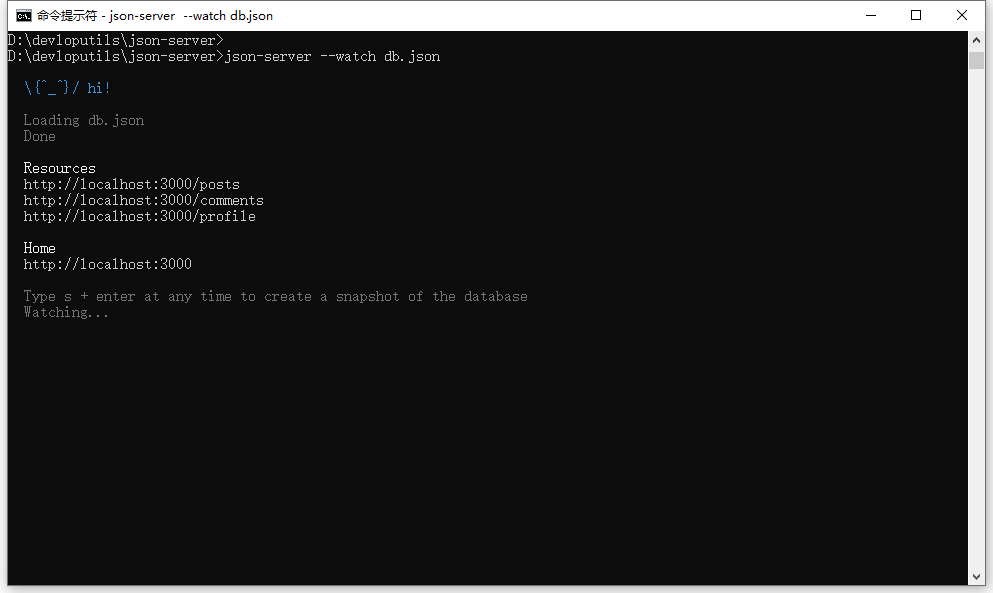只要一个json文件3分钟搭建一个json服务器
json-server是一款json数据服务器,可以对json文件、js脚本生成的json数据、远程json数据进行RESTFUL风格的增删改查操作,可以通过参数、分页、排序、全文搜索、关联查询、范围查询等进行复杂查询,对开发者特别是前端开发者是一款非常好用的开发工具。
官网:
https://www.npmjs.com/package/json-server

官网
下面我们来介绍具体的用法,
首先确保你本地安装了node.js。
安装json-server
npm install -g json-server
创建一个json文件 db.json
{ "posts": [ { "id": 1, "title": "测试标题1", "author": "张三" }, { "id": 2, "title": "测试标题2", "author": "李四" } ], "comments": [ { "id": 1, "body": "这里是内容体1", "postId": 1 }, { "id": 2, "body": "这里是内容体2", "postId": 2 } ], "profile": { "name": "测试json" } }
指定json文件运行服务,命令行运行以下命令
json-server --watch db.json

运行服务
服务器就这么搭建好了,就是这么的快,可能还不要3分钟。
增删改查-请求示例
请求方式遵循restful风格,
- GET-查询、
- POST-新增、
- PUT-修改、
- PATCH-修改属性、
- DELETE-删除
get请求-查询
可以看到资源路径都列在控制台里了,浏览网址
http://localhost:3000/posts ,出现以下结果,posts路径就是json文件里的key
[ { "id": 1, "title": "测试标题1", "author": "张三" }, { "id": 2, "title": "测试标题2", "author": "李四" } ]
POST请求-新增
使用POST请求会添加一条新记录,如POST请求:
http://localhost:3000/posts,返回新记录的id。
{ "id": 3 }
json文件也被更改
{ "posts": [ { "id": 1, "title": "测试标题1", "author": "张三" }, { "id": 2, "title": "测试标题2", "author": "李四" }, { "id": 3 } ], "comments": [ { "id": 1, "body": "这里是内容体1", "postId": 1 }, { "id": 2, "body": "这里是内容体2", "postId": 2 } ], "profile": { "name": "测试json" } }
PUT请求-修改
PUT请求会修改一条记录,如请求:
http://localhost:3000/posts/3,我们在请求body里输入以下修改内容:
{ "title":"这是修改的内容", "author":"王五" }
json文件变成了
{ "posts": [ { "id": 1, "title": "测试标题1", "author": "张三" }, { "id": 2, "title": "测试标题2", "author": "李四" }, { "title": "这是修改的内容", "author": "王五", "id": 3 } ], "comments": [ { "id": 1, "body": "这里是内容体1", "postId": 1 }, { "id": 2, "body": "这里是内容体2", "postId": 2 } ], "profile": { "name": "测试json" } }
PATCH请求-修改单个属性
PATCH与PUT的区别在于,PUT的请求内容需要包含整个对象除id外的所有属性,PATCH的请求内容可以是单个属性。
比如我们PATCH请求:
http://localhost:3000/posts/3 ,body为
{ "title":"这是修改的内容xxxx" }
json文件里id为3的记录仅title属性发生改变,其他字段不变
{ "posts": [ { "id": 1, "title": "测试标题1", "author": "张三" }, { "id": 2, "title": "测试标题2", "author": "李四" }, { "title": "这是修改的内容xxxx", "author": "王五", "id": 3 } ], "comments": [ { "id": 1, "body": "这里是内容体1", "postId": 1 }, { "id": 2, "body": "这里是内容体2", "postId": 2 } ], "profile": { "name": "测试json" } }
DELETE请求-删除
DELETE请求会删除一条数据,如请求:
http://localhost:3000/posts/3 。
删除后的json文件内容发生改变,可以看到id为3的记录没了:
{ "posts": [ { "id": 1, "title": "测试标题1", "author": "张三" }, { "id": 2, "title": "测试标题2", "author": "李四" } ], "comments": [ { "id": 1, "body": "这里是内容体1", "postId": 1 }, { "id": 2, "body": "这里是内容体2", "postId": 2 } ], "profile": { "name": "测试json" } }
过滤id
浏览
http://localhost:3000/posts/1 ,代表读取post里id为1的那条数据,注意不是代表第1条,而是id为1的那条。
{ "id": 1, "title": "测试标题1", "author": "张三" }
过滤参数
浏览
http://localhost:3000/posts?author=张三
[ { "id": 1, "title": "测试标题1", "author": "张三" } ]
如果有多级也可以用“.”+属性名查询如
http://localhost:3000/posts?author.name=张三。
排序
通过“_sort”指定排序属性和“_order”指定asc顺序还是desc倒序查询,如:
http://localhost:3000/posts?_sort=id&_order=desc 。
分页
通过“_page”和“_limit”进行分页查询,如查询第一页,每页20条查询写法:
http://localhost:3000/posts?_page=1&_limit=20
截取部分
通过“_start”、“_end”和“_limit”参数查询,如从20条开始查询10条数据:
http://localhost:3000/posts/1/comments?_start=20&_limit=10
不等于查询
通过“属性名_ne”写法如:
http://localhost:3000/posts?id_ne=1
[ { "id": 2, "title": "测试标题2", "author": "李四" } ]
大于等于/小于等于查询
通过“属性名_gte”查询大于等于,通过“属性名_lte”查询小于等于,写法如:
http://localhost:3000/posts?views_gte=10&views_lte=20
[]
like查询
通过“属性名_like”的写法查询如
http://localhost:3000/posts?title_like=标题1
[ { "id": 1, "title": "测试标题1", "author": "张三" } ]
全文搜索
通过q查询参数如:
http://localhost:3000/posts?q=标题
[ { "id": 1, "title": "测试标题1", "author": "张三" }, { "id": 2, "title": "测试标题2", "author": "李四" } ]
关联查询
通过_embed参数请求如:
http://localhost:3000/posts?_embed=comments ,代表posts关联comments。
[ { "id": 1, "title": "测试标题1", "author": "张三", "comments": [ { "id": 1, "body": "这里是内容体1", "postId": 1 } ] }, { "id": 2, "title": "测试标题2", "author": "李四", "comments": [ { "id": 2, "body": "这里是内容体2", "postId": 2 } ] } ]
指定端口
命令增加 --port参数
json-server --watch db.json --port 3004
使用js脚本生成数据代替json
创建一个index.js文件用于生成数据
module.exports = () => { const data = { users: [] } // Create 1000 users for (let i = 0; i < 1000; i++) { data.users.push({ id: i, name: `user${i}` }) } return data }
运行服务指定js文件
json-server index.js
使用远程地址加载数据
json-server http://example.com/file.json json-server http://jsonplaceholder.typicode.com/db
作为静态文件服务器
创建一个public目录,创建一个内容为hello world的index.html文件。
mkdir public echo 'hello world' > public/index.html json-server db.json
访问 http://localhost:3000/ ,根路径会默认显示public目录下的内容,会显示index.html的内容。
'hello world'
也可以通过--static参数指定其他路径的目录
json-server db.json --static ./some-other-dir
自定义请求路由
创建一个 routes.json文件用于定义请求路由,每个路径都由 / 开头。
{ "/api/*": "/$1", "/:resource/:id/show": "/:resource/:id", "/posts/:category": "/posts?category=:category", "/articles\\?id=:id": "/posts/:id" }
启动服务时指定请求路由定义文件
json-server db.json --routes routes.json
以下访问左边的路径分别对应右边的原始请求效果
- /api/posts ==》 /posts
- /api/posts/1 ==》 /posts/1
- /posts/1/show ==》 /posts/1
- /posts/javascript ==》 /posts?category=javascript
- /articles?id=1 ==》 /posts/1
更多功能可以通过json-server的官网查阅,希望本文对你有所帮助。
